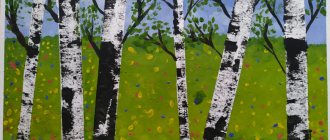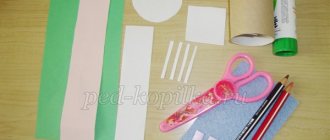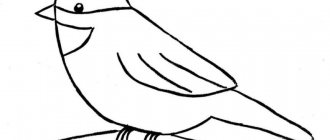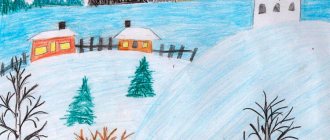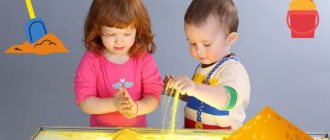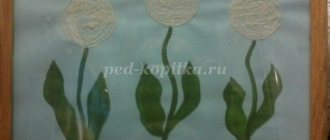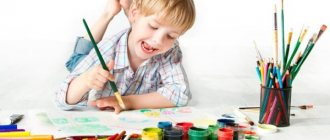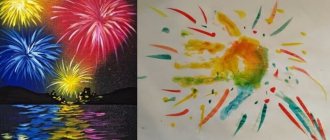Simple drawing of a birch tree
Drawing an elegant tree is not at all difficult, as you might think at first glance. Training should begin with the simplest image of it, which will be within the power of every novice artist, gradually complicating the work.
So, to begin with, you will need: a checkered notebook sheet, simple and green pencils, an eraser, black and green ballpoint pens for drawing outlines.
If this is your first experience of drawing a birch, we recommend working with a simple pencil first so that you can correct some things along the way. Let's get started.
In the center of the notebook sheet, using a simple pencil, draw the trunk of the future birch tree.
Two vertical lines, slightly widened at the base. The height of the trunk should be approximately half the size of the leaf.
- Continuing the lines of the trunk upward, we draw three large branches, i.e. the tree trunk smoothly branches first to the right, then to the left and again to the right. Make them not too wide. The ends of the branches should smoothly fall down. You can add several medium-sized branches.
- Evenly along the large branches, using falling wavy lines, we draw many thin branches up to the level of the middle of the trunk, giving the crown the most natural “weeping” look. We complete the pencil drawing by drawing the grass around the base of the tree in the form of a broken curve.
- If necessary, erase all unnecessary strokes and lines with an eraser. Draw all the lines with a black ballpoint pen. This way, the contours will become clearer.
- Take a closer look, is our tree missing something to make it look like a birch? Well, of course! Let's add distinctive black patterns resembling semicircles on the trunk and large branches in a checkerboard pattern.
It turned out to be a very nice birch tree.
Now let's move on to working on the color design of the sketch. Use a green pencil to color the grass and boldly draw the contours of the thinnest branches.
Next, along the entire length of the thin branches, with a green pen you need to draw small leaves, which are shaped like an inverted drop.
We arrange the leaves alternately, applying them to the fragile branches, left and right. To make the foliage look denser, try to space them fairly close to each other.
If your child easily managed to cope with the task, doing the work step by step, then we offer a more complex, but much more interesting technique for depicting birches below.
The easiest way to draw a birch tree
Stage 1 – make a sketch of the trunk, twigs and branches
Step by step drawing of a lush birch tree. We learn technique according to the scheme. We outline the trunk of our birch tree. We draw the base of the trunk thicker, the top thinner. Also, try to draw the tree not perfectly straight, since such trees do not exist in nature. We also outline twigs and branches. The lower the branches, the longer they are; the higher, the smaller and shorter they are, both in thickness and in length.
Don't forget to also mark the line of the ground where the birch tree grows from, and at the base you can mark a little grass.
Stage 2 – shading, drawing the bark
Using a 6B pencil, we begin to draw the bark of our birch tree. The lower part of the birch, the base, is always darker; there are practically no light places there. We apply the shading more vertically. Further, a little higher, we begin to apply more horizontal strokes. On the left and right, there are such stripes; you can also draw some small dots in the middle.
We make the left side of the birch a little darker to show that the light is coming from the right. For the branches, we also show a small bark at the base, and then we simply show the line, the plastic movement of our branches. Let's mark the grass a little. Try to press the pencil harder in some places and less in others. Don't forget about the bright areas of the birch, especially on the right side.
Stage 3 – draw leaves, shade
Next we outline the leaves. We will not draw every leaf. We draw them differently, it is not necessary that they all have an ideal shape - in some places they can be more pointed, in others more round. We draw a lot of them. Also, with a little light shading you can show the leaves in the background, but without drawing, just the general shape of the mass of leaves. Some leaves can be highlighted a little more strongly, some can be made on the contrary, light, barely noticeable, so that the plan is visible and the air is noticeable.
You can see how to draw a birch beautifully and quickly in the video at the end of this article.
Drawing birches with gouache, an unusual technique
First, you need to know that landscape is a genre of fine art in which the main subject of the image is nature, where special importance is attached to the construction of the composition, as well as the conveyance of the atmosphere, the state of the air and light.
Get ready, we will learn to draw a beautiful landscape with birches. Now we will introduce you to one interesting way of painting with gouache.
For this work you will need very unusual materials:
- a circle cut out of a white sheet of paper;
- used plastic payment card;
- adhesive masking tape 1 cm wide;
- set of gouache paints;
- paint brushes;
- a sippy cup with plain water;
- scissors.
We draw a landscape step by step:
- We place the paper circle on the surface of the desktop on the backing. We cut the masking tape with scissors into five strips, approximately equal in length to the diameter of the circle. Cut one strip in half lengthwise.
- We glue the stripes as indicated in the diagram, first the wider ones, and then in the center of the composition, at an angle, thin strips of tape. Using the sticky edges of the strips protruding beyond the circle, we secure the circle to the work surface. Now is it clear that the areas covered with tape are the trunks of the birch trees in our picture?
- Next we work with gouache. Taking a medium-sized brush, paint the sky with blue gouache, using light strokes to paint the upper part of the circle with a smooth increase in the intensity of the blue color towards the very top edge of the sky.
- To the middle of the circle, paint the space between the trees with strokes using gouache paint in green tones: from light green to light green. In the middle part of the composition we diversify the palette of colors with orange highlights.
- And now we work in the same manner to the very bottom, applying dark green gouache to the very bottom of our drawing, smoothly creating transitions from one shade of green to another. The background forbs are ready. Now let’s add red and yellow colors with a few strokes. Look at the resulting picture from above, did you really see blooming summer grasses?
- And now, let's return to our birches.
- Carefully remove the tape. Inside the circle, the slender outlines of trees remained.
- Let's apply a characteristic black pattern to the white bark in an unusual way. Attention! Apply a little black paint to the edge of the used plastic card.
- We apply the painted edge to either side of the selected trunk and, pressing tightly, stretch the card to the other side. If you did everything correctly, you will get the effect of birch bark on the trunk. Great?
- We will do a similar procedure with other birches, changing the direction of action on some of them, for example, from right to left and vice versa.
- At the top of the birches we will draw branches.
- Paint them with black paint using a thin brush.
- Finally, we casually paint the branches with green paint to create foliage.
The result was a picturesque landscape. Through the whitish trunks of birches one can see the blooming, juicy May herbs, and the expanse of heaven soars upward! The work is really worth the result, but very little time is spent on it.
Let's move on to the next master class. We will learn to draw a winter birch grove.
Non-traditional drawing techniques: meaning and tasks in the preparatory group
Children aged seven years confidently use classical drawing techniques. Colored pencils and paints are used for the work. The techniques of folk painting are studied for their technical aspects. Classical drawing classes in the preparatory group are aimed at developing independent composition, the ability to convey movement and plot on a sheet of paper. Monotonous brush strokes and pencil shading can provoke emotional burnout in students. The desire to draw fades away.
Monotony in classes discourages the desire to draw and fantasize
Unconventional drawing techniques are the creation of an image using unusual tools/materials or alternative techniques. It is recommended to combine or alternate classical drawing classes with non-standard techniques. Children gain a sense of novelty in the creative process. The imagination is activated. The use of unexpected tools - threads, toothbrushes, straws, etc. - is experimentation for a child. Children gain new knowledge and new opportunities in non-traditional drawing classes.
Unusual materials for drawing attract children and make them want to start drawing right away
The inclusion of non-traditional drawing techniques in the educational process is carried out within the framework of the preschool education program. The importance of alternative fine art techniques is significant for the education of a well-rounded personality, as required by the Federal State Educational Standard. In the preparatory group, non-traditional techniques contribute to the fulfillment of educational tasks:
- improving fine motor skills and motor coordination of hands,
- preparing the brush for writing,
- forming an idea of the properties of certain materials through research and experimentation,
- development of imaginative and logical thinking,
- development of a sense of color and shape,
- maintaining the psycho-emotional health of children,
- stimulating imagination
- the formation of a sustainable interest in independently thinking through a plan and implementing it,
- development of aesthetic taste.
Unconventional drawing is a good mood, self-confidence and the fight against fears
Winter landscape with birches in watercolor
Birches are especially beautiful in winter. Their white trunks look even thinner and more transparent, as if dissolving in space.
You can convey lightness and airiness using watercolors.
The tendency of this technique is that for work we take watercolor paints, which are first diluted with water before painting. Paints are applied in thin layers. Sometimes we additionally moisten the parchment.
The paper here is not just a canvas, but also a pictorial element: the background will become space and “air.”
If you love winter and nature, then this master class is just for you. We are starting to work on a winter landscape with birches.
Prepare the following materials:
- watercolor paints;
- paint brushes of different sizes;
- a small container of water;
- watercolor paper;
- masking tape;
- used plastic card.
Summary of GCD for drawing in the second junior group on the topic: "Birch"
Abstract of GCD for drawing" in the second junior group.
on the topic: “Birch
Goal: teach how to draw a birch tree
Tasks:
1. Develop the ability to hold a brush correctly, draw strokes, carefully pick up paint without leaving marks on the paper;
2. Develop the ability to rejoice in the awakening beauty of spring.
Progress of the lesson:
Educator:
Guys, hello! What's your mood? Look, we have received a letter. Guess what's there?
Russian beauty
Standing in a clearing
In a green blouse
In a white sundress.
Children:
Birch!
Educator: Well done.
Look how beautiful she is. Who sent it to us?
He loves to eat carrots
Ears sticking out.
Our timid "jumper"
Kids, who is this?...
Children:
Bunny!
Educator:
Well done. Right. And in the letter he asks us for help. The bunny really likes birch trees. He wants us to draw him pictures of birch trees. Shall we help?
Children:
Yes!
Educator:
Then let's begin! Guys, look at the picture of a birch tree. What is she like?
Children:
Children's answers.
Educator:
It is simply impossible to confuse birch with another tree. Only birch has such a white trunk with black spots. The shape of the leaves of the birch tree is also special - in the shape of a heart. The leaves change color from light green to dark green and yellow in the fall. Guys, during our walk we looked at the trees.
Let's remember what a tree has?
Children:
Trunk, twigs, leaves.
Educator:
What kind of trunk does a birch have?
Children:
White with black spots.
Educator:
Right. What's growing on the trunk?
Children:
Thin vodkas. And there are leaves on the branches.
Educator:
Well done. Right. You need to rest before work.
We planted a birch tree, (Straighten up.)
We poured water on her, (Bend your arms to your shoulders, palms forward.)
And the birch tree grew, (Stand up.)
Raised branches towards the sun, (Hands up.)
And then she tilted them, (Hands down, back straight.)
And she thanked the guys. (Bows head.)
Educator:
Well done guys, sit down at the tables and we will draw a birch tree with you. We will paint with watercolors. To begin with, we dip the brush in water, then pick up paint and carefully draw thin branches, then black spots on the trunk. Now rinse the brush well and pick up green paint. What will we draw? That's right, leaves. “By dipping” We draw leaves.
(during work, the teacher helps those who need help)
Educator:
What kind of tree did we draw?
How did we draw leaves on a birch tree?
I think the bunny will really like your birch trees. Let's hang them up at the exhibition, and then send them to the bunny! Well done.
How to gradually create a winter landscape with birches using watercolors:
- Use tape to secure the watercolor paper to the work surface. Pre-soak the following paints with water: blue, brown, yellow and white paint.
- Visually divide the sheet in half horizontally.
- At this stage, we moisten the upper part of the sheet.
- This is done using a wide brush dipped in clean water.
- Using a wet brush, pick up blue paint and a little brown paint and mix them. Using the resulting grayish-blue tint in the upper third of the sheet, we create the background of the composition, in the form of wavy transparent stains in shape reminiscent of trees.
- A little closer, using dense blue paint, we will draw in a zigzag pattern the pyramidal silhouettes of the fir trees.
- At the left edge there is a larger one, in the center there is a smaller one. The bottom background edge is located in the form of a convex arc.
- Using brown paint, closer to the right edge, draw two vertical lines.
- The result was tree trunks.
- As soon as the wet image dries and becomes slightly damp, take a plastic card and apply a thin layer of white paint of a thicker consistency to its edge. On a blurred background of the forest, vertically and obliquely applying and stretching the card, we draw white silhouettes of several birch tree trunks and branching zones. This group of birches will form the center of the composition.
- Next, we add black paint to the edge of the card and make marks on the white silhouettes of birch trunks. Then, we move to the lower plane. And on the white section of the sheet, in a similar way, we finish drawing the lower parts of the trunks. Pay special attention to the location of birch trees, as well as giving them advantageous shapes.
- While the upper part of the drawing dries, we will draw a stream in the foreground. Moisten the bottom of the sheet. Let's paint the open surface of the stream with mixed blue-gray paint. We apply the strokes in several steps, layer by layer, to create the effect of living water. Using darker, thicker paint, we will paint several streaks of the reflection of the birches. Using white watercolor paint we apply highlights on the surface of the water, and with blue strokes we shade the trunks from the main mass of snow.
- The top half of the drawing is completely dry. Using a thin brush, paint gray, thin, protruding branches at the tops. Around the central birches and along the banks of the stream we will depict gray tufts of dried grass. You can add some warm accents to the overall picture by applying yellowish-brownish paint to the trunks and grass.
- Using a thin brush, to give it a snowy look, we’ll “walk” along the branches of the birch trees with white paint. And finally, to add dynamics to the composition, we will depict falling snow with white paint with chaotic pokes. That's all. Carefully remove the strips of tape.
Take a look at the image from the outside and evaluate it. The result was a magnificent winter landscape.
Such a picture can take its rightful place in your home gallery.
And it will be a good gift for your family and friends.
This job is not easy!
But if you want, if you are careful and consistent, anyone can cope with it, even a child! We wish you success!
Monotype
One of the types of printed graphics, for which you will need paints, a brush and white paper. We fold the sheet in half, then unfold it and apply a design on one half. Then we fold the sheet back, pressing the drawn part tightly against the empty one. Let's unfold it and see what happens!
Butterfly drawn using monotype technique
Video lesson on drawing using the monotype technique
Photos of painted birches
How to draw a birch beautifully and quickly?
For a brighter and more realistic picture, use several shades of green for the leaves. You can even draw long yellow catkins on the birch tree.
If you want to convey windy weather, draw all the leaves in the same direction. Thin branches should also adhere to it.
Spots on the trunk and branches can be painted dark brown or black.
Don’t forget to slightly shade one side of the birch trunk, so it will look like a real one.
Draw a flowering meadow under the tree, and a river next to it. You can add a swing, children playing - whatever your heart desires. You can depict your tree against the backdrop of some landscape, for example, mountains, forest, sky with clouds floating across it, etc.
Drawing an autumn birch is similar to drawing a summer one, with the only exception that for the foliage you will need to use bright yellow, lemon and yellow-green colors, as well as a little light brown. Under the tree you can draw yellow grass strewn with fallen leaves, a boletus that has grown after mushroom rains, or, for example, a hedgehog. All this will help “revive” the picture.
Imagine in your mind what kind of birch tree you would like to draw. And then gradually implement the idea on paper.
A drawing of a birch tree on tinted or craft paper will look very interesting. You can also draw a birdhouse, a nest, or just birds singing on the branches on a birch tree.
Try it, and you will definitely end up with a beautiful birch tree!
